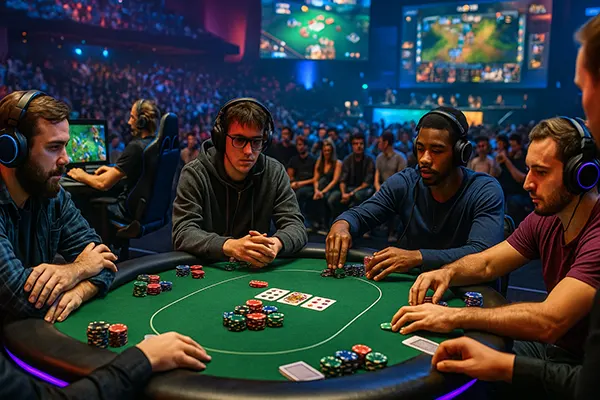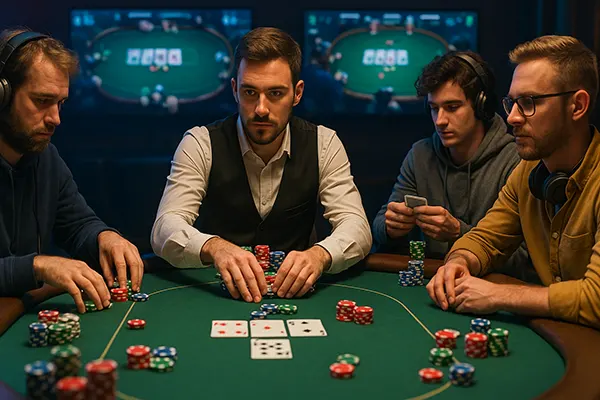
Poker in Esports: Tournaments, Collaborations with Gamers, and Shared Audience
While poker has long been associated with traditional gaming environments, its evolution in recent years has brought it into direct contact with the dynamic world of esports. With increasing convergence between strategy-based digital games and poker, new audiences are emerging, and professional players are embracing cross-discipline competitions. This article explores how poker fits into the esports ecosystem, focusing on tournaments, collaborations with prominent gamers, and overlapping community interests.
Esports Tournaments Featuring Poker
In the past decade, poker has shifted from smoke-filled casino rooms to vibrant digital competitions with real-time streams and massive international viewership. Leading esports events have started including poker-based show matches or special segments featuring top streamers and poker professionals. Platforms like PokerStars have hosted events such as “PokerStars x Twitch Rivals,” where teams of gamers and pros compete in a hybrid esports-poker format.
These events are not just entertainment — they bridge the competitive spirit of both domains. Poker’s strategic complexity aligns well with esports titles like Hearthstone, StarCraft II, and even MOBA games, where decision-making under pressure plays a key role. In tournaments like the Global Poker League, spectators enjoy a format that reflects the same storytelling, suspense, and team loyalty found in classic esports competitions.
Moreover, online qualifiers for major poker tournaments now mirror the formats used in esports. Knockout rounds, league tables, and group stages add layers of excitement. In 2025, cross-promoted tournaments such as “WPT x Esports Awards Invitational” became mainstream, gathering streamers and traditional card sharks into one digital arena, watched by hundreds of thousands online.
How Esports Formats Influence Poker Events
The influence of esports on poker has gone beyond aesthetics and branding. Tournament structures in poker have begun to resemble esports competitions in terms of pacing and audience engagement. Fast-paced Sit & Go’s with limited-entry ladders are increasingly popular, mimicking battle royale dynamics.
Leaderboards, seasonal rankings, and real-time player stats now feature prominently in online poker interfaces. These innovations, inspired by gaming platforms, provide players with a sense of progression and achievement, which is essential in modern competitive gaming environments.
Additionally, broadcasters and poker brands use Twitch-style overlays, real-time commentary, and audience interaction tools, enhancing the entertainment value and viewer retention during poker broadcasts. This shift aligns poker’s identity more closely with that of esports than ever before.
Collaborations Between Poker Brands and Gamers
Strategic partnerships between poker companies and popular esports personalities have grown steadily. Gamers with large followings on platforms like YouTube and Twitch are now brand ambassadors for major poker operators. These collaborations bring authenticity to marketing campaigns while expanding poker’s reach among younger, tech-savvy users.
One significant trend is the signing of esports influencers as sponsored poker players. For instance, in early 2025, GGPoker added multiple streamers known for games like Valorant and League of Legends to its roster. These influencers receive poker training and participate in online series, creating content that blends entertainment and learning.
Such partnerships are mutually beneficial. Poker gains exposure to a younger demographic, while streamers diversify their content and monetisation streams. Collaborative charity events, like “Cards for a Cause,” also showcase poker as a strategic and social game, not just a gambling activity, further improving its public image within gaming circles.
Gamers’ Transition into Poker
Gamers who are used to analysing probability, controlling emotion, and executing complex strategies find a natural affinity with poker. Transition stories from gaming to poker are now common. Professional esports players who retire from competitive gaming often shift to poker as a second career.
These transitions are visible in live-streamed poker sessions, where former esports pros compete in online cash games or tournaments. They openly discuss similarities between their disciplines — from reading opponents to maintaining focus for extended periods. Their presence attracts both their followers and poker regulars, creating a blended audience.
Notable examples include players like Lex Veldhuis, who started as a StarCraft competitor and became a high-stakes poker streamer. Their journeys offer validation that poker is not merely a game of luck, but a field that rewards skill, preparation, and discipline — much like professional gaming.

Shared Audiences and Community Dynamics
The merging of poker and esports has cultivated a shared audience that values mental challenge, competition, and digital-first experiences. Both communities are tech-literate, stream-friendly, and value authenticity over corporate presentation. This demographic overlap has encouraged cross-platform promotions and hybrid tournaments that engage both camps simultaneously.
Statistical data from 2024–2025 show that over 40% of regular poker players also follow at least one esports title. Conversely, esports viewers increasingly report interest in strategy-based games outside the traditional competitive space, with poker leading the list. The rise of mobile poker apps with gamified features further blurs the boundaries.
Fanbases around poker streamers often mirror the dynamics seen in gaming fandoms: shared Discord servers, custom emojis, memes, and watch parties are common. These social structures allow brands and organisers to build loyalty and run campaigns that feel community-driven rather than top-down.
Content Creation and Audience Engagement
In 2025, poker-related content on YouTube and Twitch incorporates storytelling and pacing seen in esports. Highlights, “bad beat” compilations, and educational series cater to the short-form content demand of modern audiences. Esports editing styles are being adopted by poker editors to attract more engagement.
Moreover, poker training streams now resemble gaming tutorials — with HUD displays, hotkey breakdowns, and reaction-based thumbnails. These shifts demonstrate the mutual influence of both worlds. As poker creators adopt more interactive and reactive content models, engagement levels have reached historic highs.
The competitive edge is maintained through real-money stakes, but the educational and community aspects ensure long-term viewer retention. In this blended entertainment landscape, poker’s evolution into an esports-adjacent discipline seems not just logical but inevitable.

